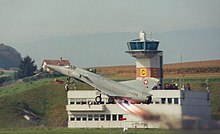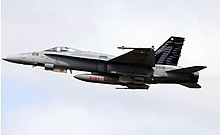Alarm riot

An alarm squad is a squad of two or three fighters or interceptors that are available around the clock for take-off ( Quick Reaction Alert ) throughout the year in the shortest possible time in order to maintain the integrity of the air sovereignty of a state in its territory .
General
Alarm rotas can be used in the event of airspace violations or other serious incidents in the airspace (e.g. aircraft hijackings ), or to provide support with technical problems. After the alarm has been raised, the alarm group must be in the air within a specified time (e.g. 15 minutes). Depending on the alarm situation, these times can be shortened to 10 or 5 minutes. At 10 minutes the pilots are already in the cockpit, at 5 minutes the machines are ready to take off on the runway . As an instrument for safeguarding national sovereignty and security, alarm rotten are subject in principle to national authority. The provision of alarm groups and the authority to order their deployment can, however, also be regulated within the framework of alliance agreements or bilateral agreements. The authority to order an alarm raid is regulated differently in the nations. In Great Britain, for example, the authority to command lies entirely with the military and not the political leadership. Special attention was given the air traffic control (Air Policing) after the attacks of September 11, 2001 in the USA , since with timely alert and clear chain of command a QRA might have been able to prevent these attacks.
If an alarm start is ordered, the crews can carry out visual identification after approaching a suspicious aircraft.
If an aircraft enters the airspace of a NATO country without permission, the management of the alarm riot rests with the member of the alliance concerned.
Standardized maneuver
Signals standardized internationally by the ICAO are used for communication . As a sign of the interception process, an interceptor is positioned slightly forward, laterally offset, on the left side of the aircraft to be intercepted, in order to enable the pilot of the machine to be intercepted to have visual contact with the interceptor. The machine "addressed" in this way should then signal by wiggling its wings that it wanted to follow the alarm riot. Then the hunter would initiate a change of course, for example in the direction of an airfield.
If it is not possible to bring the aircraft under control or to push it away, and z. B. the risk of an (intentional) crash with far-reaching further consequences, there is the possibility of shooting down the machine in many countries, for example the USA.
In individual cases it has already been possible to wake impotent pilots again or to bring smaller, driverless machines on course into uninhabited areas by cutting under the wing (additional one-sided lift). A similar flight maneuver has already been successfully used by the British Royal Air Force against approaching V1 , in order to bring them off course and crash; the British fighters touched z. Sometimes even deliberately the wings to reinforce the maneuver by a physical impulse, since the automatic control by the gyrocompass of the V1 then usually collapsed.
The alarm riot is usually housed in specially built hangars at one end of a runway in order to guarantee short distances to the start in the event of an alarm. For this purpose, the hunters may also use the runways as a taxiway to reach their take-off position, which otherwise contradicts the safety rules of proper flight operations. The hangars are usually specially secured to prevent sabotage . A total of around 50 people in a squadron are prepared around the clock for this emergency. In addition to the pilot and usually five technicians, the on-call team also includes the squadron command post, the air base fire brigade, the air doctor and the crew of the tower and radar .
Situation in Germany
In the German Air Force , the Tactical Air Force Wing 71 "Richthofen" for the northern airspace, the Tactical Air Force Wing 74 for the southern airspace and, if necessary, the Tactical Air Force Wing 73 "Steinhoff" (especially for the eastern airspace) provide the alarm groups. The National Situation and Command Center for Security in Airspace is nationally responsible for the entire German airspace as a military part of the National Air Defense Command Center (FüZNatLV) in Uedem . This is where representatives from the Air Force, the Ministry of the Interior and flight security sit together and decide on how to proceed.
In Germany, the task of the alarm riot was initially carried out by the F-4 Phantom II on both fighter squadrons . In June 2008 the Eurofighter took over these air-sovereign tasks at JG 74. With the introduction of the Eurofighter in the Lw Grp "Richthofen" cycle in April 2013, the last Phantom were taken out of service by the Air Force. Until then, the F-4 Phantom II and Eurofighter flew joint training missions.
With the Aviation Security Act passed in Germany at the beginning of 2005 , the legal basis was to be created. B. when attempting to use an aircraft as a flying bomb , allow the crews of the fighter aircraft to shoot it down on the instructions of the Minister of Defense . On February 15, 2006, the Federal Constitutional Court declared the relevant paragraph unconstitutional and invoked the ban on quantification . It also ruled in April 2013 that it is not the Defense Minister but only the German Federal Government that may decide in urgent cases.
Situation in Switzerland
The airspace of Switzerland and Liechtenstein was monitored with radar after the first SFR system went into operation . Since January 1, 2005, this has been happening continuously 24 hours a day with the FLORAKO system . Switzerland only provided airspace surveillance with live ammunition on special occasions such as the WEF and international conferences such as the G8 summit in Évian . After the hijacked Ethiopian Airlines flight 702 landed in Geneva outside the operating hours of the Swiss Air Force (although the Air Force would not have been involved in day-to-day operations), the project , the ability to intervene in the air police service outside normal working hours , or ILANA for short , was pushed forward. From January 4, 2016 onwards, two armed F / A-18s stood by on QRA (Quick Reaction Alert) Monday through Friday from 8:00 a.m. to 6:00 p.m. From January 2, 2017, this presence was guaranteed from 8 a.m. to 6 p.m. every day (including Saturday, Sunday and public holidays). Since January 1, 2019, the jets have been ready from 6 a.m. to 10 p.m. and at the end of 2020 they will be expanded to 24 hours a day, 365 days a year. An immediate increase to this readiness is not possible because there is a lack of staff and the training time and the number of training places for pilots and military air traffic controllers determine the limits. At the Swiss Air Force, the QRA is used not only for emergencies, so-called HOT missions, but also for LIVE missions in which foreign state aircraft are routinely checked. The F / A-18s, which are available for QRA service, are not only equipped with the on - board cannon, but also with Chaffs , Flares , AIM-9 Sidewinders and AMRAAMs , infrared ( Advanced Targeting Forward-Looking Infrared ) and an additional tank with a red Script is the international emergency frequency STBY 121.50 . The main operational base for QRA readiness is the Payerne military airfield , but the airfields in Emmen and Meiringen are also used as QRA bases for a few weeks a year. The Sion military airfield also has the necessary infrastructure. QRA deployments from the civil national airports of Zurich and Geneva are possible, but only foreseen in exceptional cases. From the entire F / A-18 fleet, each aircraft is assigned to the QRA service for some time in order to distribute an even number of flying hours to all 30 F / A-18s of the Swiss Air Force. All three F / A-18 squadrons ( Fliegerstaffel 11 , Fliegerstaffel 17 and Fliegerstaffel 18 ) of the Luftwaffe's professional aviation corps deploy pilots for the QRA service. The two pilots who together make up the QRA do not necessarily have to be of the same squadron.
Situation in Austria
The Austrian Armed Forces are keeping two Eurofighters in readiness at the Hinterstoisser Air Base in Zeltweg .
See also
literature
- Philipp Rabe: Security in the airspace: Nothing escapes the Air Force. In: FliegerRevue , No. 7/2020, pp. 26–28
Web links
- The air force alarm riot . Website of the German Air Force , September 2011.
Individual evidence
- ↑ Police du ciel, première intervention le week-end!
- ↑ Hasnain Kazim: Audio recordings before the Su-24 was launched: “You are approaching Turkish airspace!” Spiegel online, November 26, 2015, accessed on July 28, 2017 .
- ↑ sueddeutsche.de: Only the federal government is allowed to deploy the Bundeswehr inside
- ↑ Media information from the federal authorities of the Swiss Confederation , November 17, 1999
- ↑ Maurer wants to create over a hundred new jobs , NZZ, February 19, 2014
- ↑ Presentation of the structure of the air police service 24h ( page no longer available , search in web archives ) Info: The link was automatically marked as defective. Please check the link according to the instructions and then remove this notice.
- ↑ Picture F / A-18C with "121.50" RUNT .
- ↑ Surveillance Squadron . In: bundesheer.at . January 11, 2017. Retrieved January 11, 2017 .
- ↑ Eurofighters secure the airspace. In: militaeraktuell.at . January 17, 2016, accessed January 11, 2017 .

